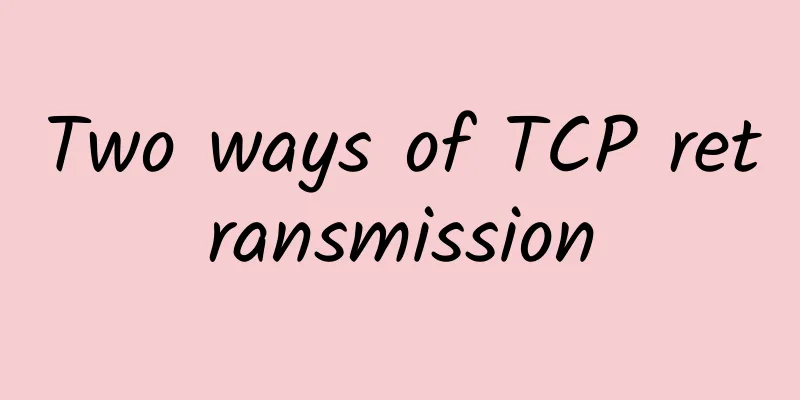Two ways of TCP retransmission

|
There is no communication without errors. This sentence shows that no matter how perfect the external conditions are, there will always be the possibility of errors. Therefore, in the normal communication process of TCP, errors may also occur. Such errors may be caused by packet loss, packet duplication, or even packet disorder.
During the TCP communication process, the TCP receiving end will return a series of confirmation information to determine whether an error occurs. Once packet loss occurs, TCP will start a retransmission operation to retransmit the data that has not yet been confirmed. TCP retransmission has two modes, one is based on time, the other is based on confirmation information. Generally, retransmission based on confirmation information is more efficient than retransmission based on time. So from this point we can see that TCP's confirmation and retransmission are both based on whether the data packet is confirmed. TCP sets a timer when sending data. If no confirmation information is received within the time specified by the timer, a corresponding timeout or timer-based retransmission operation will be triggered. The timer timeout is usually called the retransmission timeout (RTO). But there is another way that does not cause delay, which is fast retransmit. Each time TCP retransmits a message, the retransmission time will be doubled. This "doubling of the interval time" is called binary exponential backoff. When the interval time doubles to 15.5 minutes, the client will display
TCP has two thresholds to decide how to retransmit a segment. These two thresholds are defined in RFC[RCF1122]. The first threshold is R1, which indicates the number of times it is willing to try to retransmit. Threshold R2 indicates the time when TCP should give up the connection. R1 and R2 should be set to at least three retransmissions and 100 seconds to give up the TCP connection. It should be noted here that for the connection establishment message SYN, its R2 should be set to at least 3 minutes, but the setting methods of R1 and R2 values are different in different systems. In Linux systems, the values of R1 and R2 can be set by the application, or by modifying the values of net.ipv4.tcp_retries1 and net.ipv4.tcp_retries2. The variable value is the number of retransmissions. The default value of tcp_retries2 is 15. This number of retries takes about 13 to 30 minutes. This is just an approximate value. The final time depends on RTO, which is the retransmission timeout. The default value of tcp_retries1 is 3. For the SYN segment, the two values of net.ipv4.tcp_syn_retries and net.ipv4.tcp_synack_retries limit the number of SYN retransmissions. The default value is 5, which is about 180 seconds. Windows operating system also has R1 and R2 variables, their values are defined in the following registry
One of the most important variables is TcpMaxDataRetransmissions, which corresponds to the tcp_retries2 variable in Linux, and its default value is 5. This value means the number of times TCP has not confirmed the data segment on the existing connection. Fast RetransmitWe mentioned fast retransmit above. In fact, the fast retransmit mechanism is triggered based on the feedback information from the receiving end, and it is not affected by the retransmission timer. Therefore, compared with timeout retransmission, fast retransmit can effectively repair packet loss. When out-of-order messages (such as 2 - 4 - 3) arrive at the receiving end during the TCP connection, TCP needs to generate a confirmation message immediately. This confirmation message is also called a duplicate ACK. When an out-of-order message arrives, the repeated ACK must be returned immediately without delay. The purpose of this is to tell the sender that a segment of the message arrived out of order, and the sender is expected to point out the sequence number of the out-of-order segment. There is another situation that can also cause duplicate ACKs to be sent to the sender, that is, the subsequent message of the current message segment is sent to the receiver, which can be used to determine whether the message segment of the current sender is lost or delayed. Because the consequences of these two situations are that the receiver does not receive the message, but we cannot determine whether the message segment is lost or not delivered. Therefore, the TCP sender will wait for a certain number of duplicate ACKs to be received to determine whether the data is lost and trigger a fast retransmission. Generally, the number of this judgment is 3. This text description may not be clear to understand. Let's take an example. As shown in the figure above, segment 1 is successfully received and confirmed as ACK 2. The receiver's expected sequence number is 2. When segment 2 is lost, segment 3 arrives out of order, but it does not match the receiver's expectations, so the receiver will send redundant ACK 2 repeatedly. In this way, before the timeout retransmission timer expires, after receiving three consecutive identical ACKs, the sender will know which segment is lost, so the sender will resend the lost segment, without having to wait for the retransmission timer to expire, greatly improving efficiency. SACKIn the standard TCP confirmation mechanism, if the sender sends data between sequence numbers 0 and 10000, but the receiver only receives data between 0 and 1000, and 3000 and 10000, and the data between 1000 and 3000 has not reached the receiver, the sender will retransmit the data between 1000 and 10000, which is actually unnecessary because the data after 3000 has been received. However, the sender cannot perceive the existence of this situation. How to avoid or solve this problem? In order to optimize this situation, we need to let the client know more information. In the TCP segment, there is a SACK option field, which is a selective acknowledgment mechanism. This mechanism can tell the TCP client, in our common language: "I am allowed to receive a maximum of 1000 segments, but I received 3000-10000 segments. Please give me segments between 1000-3000." However, whether this selective confirmation mechanism is enabled is also affected by a field, which is the SACK allow option field. The communicating parties add the SACK allow option field in the SYN segment or SYN + ACK segment to notify the other host whether it supports SACK. If both parties support it, the SACK option can be used in the subsequent SYN segment. It should be noted here that the SACK option field can only appear in the SYN segment. Spurious timeouts and retransmissionsIn some cases, even if there is no segment loss, it may still trigger a message retransmission. This retransmission behavior is called a spurious retransmission. This retransmission is unnecessary and may be caused by a spurious timeout, which means that a timeout is determined too early. There are many factors that cause spurious timeouts, such as out-of-order arrival of segments, duplicate segments, ACK loss, etc. There are many ways to detect and handle pseudo timeouts, which are collectively referred to as detection algorithms and response algorithms. The detection algorithm is used to determine whether a timeout has occurred or a timer retransmission has occurred. Once a timeout or retransmission occurs, the response algorithm will be executed to cancel or mitigate the impact of the timeout. The following are several algorithms, and this article will not go into these implementation details:
Packet out of sequence and packet duplicationAbove we discussed how TCP handles packet loss. Now let’s discuss the issues of packet disorder and packet duplication. Packet out of orderThe out-of-order arrival of data packets is a very common phenomenon on the Internet. Since the IP layer cannot guarantee the order of data packets, each data packet may be sent over the link with the fastest transmission speed at the current situation. Therefore, it is very likely that three data packets A -> B -> C are sent, and the order of data packets arriving at the receiving end is C -> A -> B or B -> C -> A, etc. This is a phenomenon of packet out-of-order. In packet transmission, there are mainly two types of links: forward link (SYN) and reverse link (ACK). If the disorder occurs in the forward link, TCP cannot correctly determine whether the data packet is lost. Both data loss and disorder will cause the receiving end to receive out-of-order data packets, resulting in gaps between data. If the gap is not large enough, this situation has little impact; but if the gap is large, it may cause false retransmissions. If the disorder occurs in the reverse link, the TCP window will move forward, and then duplicate ACKs that should be discarded will be received, causing unnecessary traffic bursts at the sender and affecting the available network bandwidth. Back to the fast retransmit we discussed above, since fast retransmit is initiated based on the inference of packet loss based on duplicate ACKs, it does not need to wait until the retransmission timer times out. Since the TCP receiver will immediately return ACKs to received out-of-order packets, any out-of-order packets in the network may cause duplicate ACKs. Assuming that once an ACK is received, the fast retransmit mechanism will be initiated. When the number of ACKs surges, a large number of unnecessary retransmissions will occur, so fast retransmit should reach the duplication threshold (dupthresh) before triggering. However, severe out-of-order transmission is not common on the Internet, so the value of dupthresh can be set as small as possible. Generally speaking, 3 can handle most situations. Packet DuplicatePacket duplication is also a rare situation on the Internet. It means that during network transmission, a packet may be transmitted multiple times. When retransmission is generated, TCP may be confused. Packet duplication may cause the receiver to generate a series of duplicate ACKs, which can be resolved using SACK negotiation. |
<<: Interviewer: Tell me what happens after you enter the URL in the address bar and press Enter?
>>: What is an access network?
Recommend
In the past six years, the total financing of my country's 5G industry has reached 127.874 billion yuan, with China Unicom leading the way
5G commercial use is about to enter the fast lane...
China Mobile and China Broadcasting Corporation initiate strategic cooperation to jointly build and share 700MHz 5G network
On January 27, China Mobile and China Broadcastin...
Ministry of Industry and Information Technology: Promote 5G application innovation in the field of industrial Internet
On June 8, the Ministry of Industry and Informati...
PacificRack removed old packages and unilaterally raised renewal prices, offering 50% discount on new packages for the first month
I haven't shared information about PacificRac...
Do you know the role of API Gateway?
[[266934]] API Gateway The following three scenar...
GSA report: 63 operators around the world have launched commercial 5G services
The latest global 5G network development report f...
HostHatch: Hong Kong/Tokyo/Singapore AMD EPYC series starting from $25/year, 2GB/25G NVMe/1TB monthly traffic
HostHatch has released a new promotion plan on LE...
In the first half of the year, Internet companies above designated size achieved business revenue of 695.1 billion yuan, a year-on-year increase of 25.6%.
Recently, the Ministry of Industry and Informatio...
Five signs SCVMM isn't right for your data center
Today, System Center Virtual Machine Manager (SCV...
Juniper Networks' Shaowen Ma: The best SDN controller for cloud computing
[51CTO.com original article] The interview with M...
[Closed] Arkecx 40% off, Hong Kong/Taiwan/Japan/Korea/USA etc. starting from $72/year
[Updated in August 2023] Please note that the off...
How to solve VirtualBox bridged networking problems?
【51CTO.com Quick Translation】Let's assume tha...
Four challenges in securing multi-cloud networks
Today's organizations are not only actively m...
Authoritative interpretation from the Ministry of Industry and Information Technology: What exactly is "5G+Industrial Internet"?
[[415906]] Recently, the Information and Communic...
80VPS: Japan/Hong Kong CN2 server 600 yuan/month, E5/16G/1TB/20M bandwidth
80VPS is an early-established comprehensive netwo...









